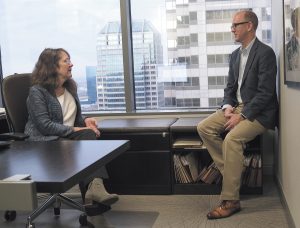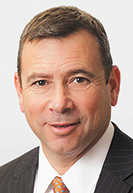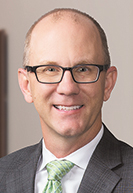Subscriber Benefit
As a subscriber you can listen to articles at work, in the car, or while you work out. Subscribe NowQuarles & Brady had been “California Dreamin’” for 10 years.
The AmLaw 200 firm, which has a big footprint in the Midwest including an office in Indianapolis, had been eyeing the Golden State in search of a merger partner for a decade, according to Michael Aldana, Quarles managing partner and chair. With offices already in Phoenix and Tucson, Arizona, the firm saw the need to serve clients by extending its reach the rest of the way to the Pacific.
Quarles stopped dreaming Jan. 1, when its combination with San Diego-based Paul Plevin Sullivan & Connaughton became effective. While geography, practice areas and financials were integral parts of the merger talks, talent and culture fit were essential to completing the deal.
“That was really important to us that we know that the people had connections on the cultural side as well as on the client side,” Aldana said. “… When we met Paul Plevin last year, (we had) connections both on the practice group side, lots of client and industry overlap. But ultimately, it was the shared values and the shared culture that we discovered we had, which it just ended up ticking all the boxes and it was pretty phenomenal in that sense.”
Law firm combinations have been on the uptick since slumping in 2020. Fairfax Associates reported just 40 law firm mergers were completed in 2020, about a 30% decline from the 59 tracked in 2019. Merger activity increased slightly to 41 completions in 2021 and 46 in 2022.
Firms holding an Indiana address have been part of the combinations in the past couple of years.
Notably, in 2021, Dinsmore & Shohl entered the Hoosier market through a merger with the former Wooden McLaughlin while the Washington, D.C.-based Crowell & Moring got an Indianapolis office through its merger with Brinks Gilson & Lione.
Stoll Keenon Ogden arrived in the Circle City last year by merging with the former Katz Korin Cunningham. Also, Taft Stettinius & Hollister expanded to Detroit via Jaffe Raitt Heuer & Weiss, becoming one of just two completed mergers during 2022 where both firms had at least 100 attorneys.
Finally, Dinsmore and Frost Brown Todd joined Quarles in starting 2023 by completing combinations with California firms.

Kristin Stark, principal at Fairfax, said she expects combinations will continue to increase in 2023, especially because firms concerned about growing in the market still look to mergers as a pathway to expansion.
As with Quarles, law offices are paying very close attention to culture and personalities when courting a merger partner. Expertise in certain practice areas is equally, if not more, important than location, Stark said. In addition, high-quality lawyers, as reflected in their education and credentials, are greatly valued.
“We’ve seen firms walk away from combinations because they have concerns that even though they might like the practice, they might like the geography, they might like the people, they are concerned about whether or not the quality is there,” she said.
Getting comfortable
Joe Williams and James Piatt did not have any doubt about quality when their former law partner, Ron Waicukauski, called to inquire about their interest in merging with Price Waicukauski Joven & Catlin.
In 2021, Williams and Piatt were evaluating the next step for their small personal injury practice, but the offer from Waciukauski presented the pair with an unexpected opportunity to also join with attorneys Carol Joven and Brad Catlin. All the attorneys had long crossed paths, worked together and, Williams said, mutually respected each other’s legal skills.
Even so, Williams and Piatt did their due diligence. The pair met with the three other attorneys individually to talk about their practices and their professional futures. Also, Williams and Piatt wanted to make sure the trio was comfortable with merging.
“I think meeting separately was important so that we could hear from each person how they wanted to be integrated,” Piatt said. “… You also have to make sure it works from a business perspective, how they want to work and what they want to work on in complement with what we’re already doing.”
Getting the attorneys and support staff from the different firms comfortable with a merger is paramount for many firm leaders. As the talks become more serious, the respective teams will meet and socialize, which will help the leadership not only assess the cultural fit but also retain the talent post-merger.
Moreover, the executive committees will review the data to determine how well the firms will mesh. Stark pointed out comparisons of billing rates and types of clients can highlight commonalities and differences in the caliber of expertise, as well as how well the practices and client bases will fit.
After the merger, most firms will see a “reasonable percentage” of departures, Stark said. But the process accompanied by the rising excitement of merging results in a lower rate of turnover than attorneys who join by lateral hire.

Both Aldana and Michael “Misha” Rabinowitch, managing partner of Dinsmore’s Indiana offices, noted the importance of economics to retaining attorneys. Leaders must show attorneys how their practices and clients will benefit from the merger, and the compensation must be competitive.
Yet firms do not have to offer the biggest paychecks to get attorneys who will stick around.
“I came up through the ranks; I don’t think it’s changed in this regard,” Rabinowitch said. “I just wanted to grow and learn every day and to be challenged and to be rewarded for my effort. But I think you also have to provide young lawyers the opportunity to create their own path.
“That is even more true nowadays — young lawyers want to be able to chart their own course,” he continued. “They want to go out and develop their own clients and business. So I think culture, opportunity and compensation are all important aspects of retaining talent.”
Integrating
These days, the task of integrating merged firms is coinciding with a generational shift that managing partners are noticing in attorneys’ career goals — namely, associates and young partners are not as likely to spend their entire professional life at a single firm billing 2,500 hours a year.

Dinsmore and Quarles are addressing the shift by switching from the traditional law firm expectation that lawyers will either be partners in seven years or they will be gone. The two firms have programs and professionals to help their attorneys identify and achieve their goals, even if that means the team member will leave to go in-house, run a nonprofit or teach.
Providing such support also creates an allegiance that could result in new business. Former team members are likely to call their former firms when they need outside counsel.

“We want you to be Dinsmore for life, but that doesn’t mean you have to be here for life,” Joshua Lorentz, Dinsmore managing partner and chair, said. “… We understand that people want different things. And when you help people get to where they want to go, they’ll remember you in a positive way.”
Joel Tragesser joined Quarles when the firm opened a new office in Indianapolis in May 2014 and stocked it with lateral hires.
Now the managing partner for the Indianapolis office, Tragesser underscored the benefit of being intentional in integration, remembering learning how he could develop his practice and being assigned an “integration partner,” who was a Quarles attorney available to provide whatever help he needed. Also, he said, the firm enhances cohesion by offering career development opportunities and tapping partners from across the offices to serve in firm-wide leadership positions.
“You can’t just hope for it to happen,” he said. “You have to have a plan. You have to have steps and you have to execute on that plan.”•
Please enable JavaScript to view this content.
